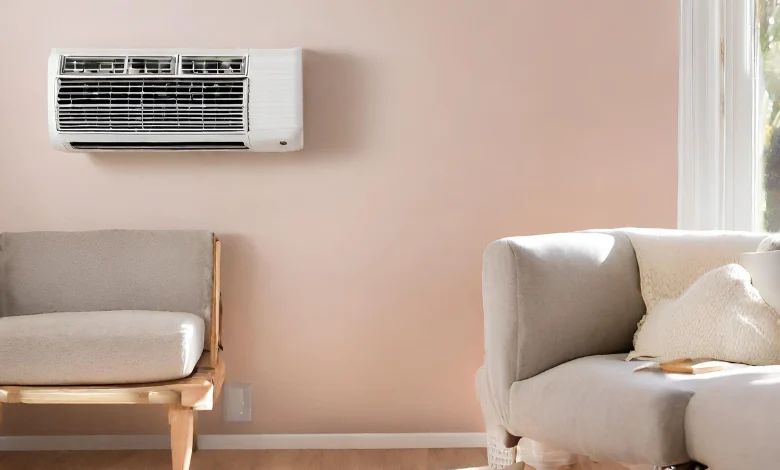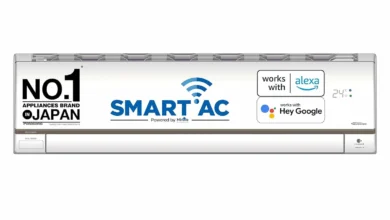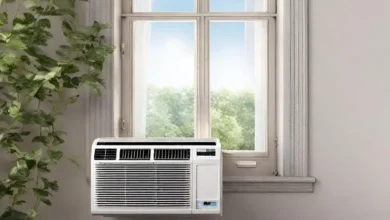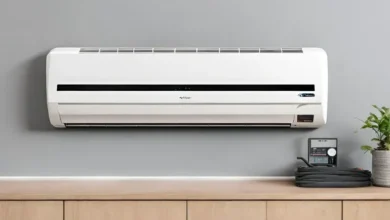Choosing the Perfect Air Conditioner Size for Your Room: A Comprehensive Guide

In the scorching heat of summer, an efficient air conditioner is a lifesaver. However, the quest for the perfect cooling solution begins with selecting the right air conditioner size. This decision is not just about comfort; it’s about energy efficiency, cost savings, and overall satisfaction with your indoor environment.
I. Choosing the Perfect Air Conditioner Size for Your Room
1. Importance of Selecting the Right Air Conditioner Size
The gravity of selecting the appropriate air conditioner size cannot be emphasized enough. The repercussions of this decision ripple through the efficiency, comfort, and longevity of your cooling system. Opting for an undersized unit is akin to inviting discomfort into your living space. Such a system will struggle to meet the cooling demands, leading to inadequate temperature regulation and, in some cases, potential breakdowns due to overworking. On the flip side, choosing an oversized unit might seem like a generous provision for cooling, but it brings its own set of challenges. The frequent cycling on and off can result in unnecessary wear and tear, inefficiency, and, ultimately, elevated energy bills.
2. Impact on Energy Efficiency and Comfort
The crux of the sizing dilemma lies in its profound impact on energy efficiency. A properly sized air conditioner is the linchpin for optimal operation, effectively managing your energy consumption. This not only translates to economic benefits for your wallet but also resonates with a broader environmental consciousness. A system that matches the size requirements of your space ensures that you are not overconsuming energy, contributing to a more sustainable and eco-friendly living environment.
Moreover, the significance of the right-sized air conditioner extends to the realm of comfort. Beyond just regulating temperature, an accurately sized unit guarantees a consistent and comfortable atmosphere throughout your space. Say goodbye to hot spots and uneven cooling – the right size ensures that every nook and cranny of your room receives the cooling attention it deserves. This not only enhances the overall comfort of your living environment but also eliminates the need for constant thermostat adjustments, providing a seamless and enjoyable indoor experience.
II. Understanding Air Conditioner Sizing
1. BTU (British Thermal Units) Explained
British Thermal Units (BTU) are the industry standard for measuring cooling capacity. Understanding BTU is fundamental to selecting an air conditioner that can handle the thermal load of your specific space. The basic principle is that larger rooms or spaces with higher heat loads require air conditioners with higher BTU ratings.
2. Factors Affecting Room Size and Cooling Requirements
When determining the ideal BTU rating for your air conditioner, several factors come into play. The square footage of your room is a primary consideration, but it’s not the sole determinant. Insulation quality, the number of occupants, and the level of sunlight exposure are equally critical factors that influence your cooling requirements.
1. Square Footage
The square footage of your room is the foundational factor in sizing your air conditioner. Larger rooms naturally require more cooling power.
2. Insulation
Well-insulated rooms retain cool air more effectively, reducing the workload on your air conditioner. Insulation quality is crucial in determining the actual cooling needs of your space.
3. Number of Occupants
The number of people in a room contributes to the overall heat load. More occupants mean additional heat, impacting the cooling requirements of your air conditioner.
4. Sunlight Exposure
Rooms with extensive sunlight exposure absorb more heat. Considering the orientation of your room and the duration of sunlight exposure helps in accurately assessing cooling needs.
III. Assessing Your Room
1. Measuring Square Footage Accurately
Accurate measurement of your room’s square footage is the first step in determining the appropriate BTU rating for your air conditioner. Measure each room individually, accounting for irregularities in shape.
2. Considering Ceiling Height
Ceiling height plays a crucial role in the overall volume of your space. Taller rooms require more cooling power, so take accurate measurements to factor in this aspect of your room.
3. Evaluating Insulation Quality
Inspecting the insulation quality of your room is essential. Well-insulated walls and windows contribute to maintaining a consistent temperature and reduce the workload on your air conditioner.
4. Identifying Heat-Generating Appliances and Electronics
The appliances and electronics in your room generate heat. Identify and take note of these sources, as they contribute to the overall heat load your air conditioner must handle.
IV. Calculating BTU Requirements
1. Using BTU Calculators and Formulas
Numerous online calculators and formulas are available to help you determine the BTU requirements for your room. These tools consider various factors such as square footage, insulation, and sunlight exposure to provide accurate results.
2. Factoring in Specific Room Conditions
While calculators provide a general estimate, factoring in specific room conditions is crucial for precise BTU calculations. For example, a kitchen or a server room may require additional cooling capacity due to higher heat loads.
3. Adjusting for Climate and Regional Temperature Variations
Climate and regional temperature variations impact your cooling needs. Adjust your BTU calculations based on the average temperatures in your region and the specific climate conditions you experience.
V. Common Mistakes to Avoid
1. Choosing an Undersized Air Conditioner
Opting for an undersized air conditioner is a common mistake that can lead to discomfort and increased energy bills. An undersized unit will struggle to cool your space adequately, working harder and less efficiently.
2. Oversizing and Its Negative Consequences
Conversely, choosing an oversized air conditioner comes with its own set of issues. While it may cool the space quickly, it tends to cycle on and off frequently, leading to inefficient operation, temperature fluctuations, and increased wear on the system.
3. Ignoring Insulation and Other Factors
Neglecting insulation quality, occupancy, and sunlight exposure can result in inaccurate sizing. It’s essential to consider all relevant factors to ensure your air conditioner meets the specific needs of your space.
VI. Types of Air Conditioners and Their Sizing
1. Window Units
Window air conditioners are suitable for cooling individual rooms. When selecting a window unit, consider the size of the room and the unit’s BTU rating to ensure optimal performance.
2. Split-System Air Conditioners
Split-system air conditioners consist of both indoor and outdoor units. The sizing of these units depends on the total square footage they need to cool.
3. Portable Air Conditioners
Portable air conditioners are versatile and easy to move around. Consider the BTU rating and room size when choosing a portable unit for effective cooling.
4. Ductless Mini-Split Systems
Ductless mini-split systems offer flexibility in cooling different zones. Sizing considerations include the total square footage of the areas being cooled.
5. Central Air Conditioning
Central air conditioning systems cool an entire home. Proper sizing is crucial to ensure consistent comfort throughout all rooms.
VII. Energy Efficiency Considerations
1. SEER Ratings and Their Significance
Seasonal Energy Efficiency Ratio (SEER) ratings indicate the efficiency of an air conditioner. Higher SEER ratings reflect better energy efficiency. Consider the SEER rating when choosing an air conditioner for long-term energy savings.
2. Impact of Proper Sizing on Energy Consumption
The correct sizing of your air conditioner directly impacts energy consumption. An adequately sized unit operates efficiently, leading to lower energy bills and reduced environmental impact.
3. Long-Term Cost Savings
While the initial cost of a properly sized, energy-efficient air conditioner may be higher, the long-term cost savings in terms of lower energy bills and reduced maintenance expenses make it a wise investment.
VIII. Consulting with HVAC Professionals
1. Importance of Professional Assessments
Seeking professional assistance is crucial in ensuring accurate sizing and optimal performance. HVAC professionals can conduct thorough assessments based on your specific needs.
2. Getting Expert Advice on Sizing and Installation
Professionals not only help with sizing but also provide valuable advice on installation. Proper installation is essential for the efficient and reliable operation of your air conditioner.
IX. Budget Considerations
1. Balancing Cost and Efficiency
Balancing your budget with your cooling needs is a critical consideration. While investing in a high-eff
iciency air conditioner may have a higher upfront cost, the long-term energy savings often outweigh the initial expense.
2. Exploring Financing Options
Explore financing options to make the upfront cost more manageable. Many manufacturers and HVAC companies offer financing plans, allowing you to spread the cost over time.
X. Conclusion
1. Summarizing Key Points
Selecting the right air conditioner size is not just about comfort—it’s about efficiency, cost savings, and environmental impact. Accurate measurements, thorough assessments, and professional advice are crucial in making an informed decision.
2. Emphasizing the Importance of Proper Sizing for Optimal Performance
In conclusion, the key to a well-functioning air conditioning system lies in its size. Optimal performance, energy efficiency, and long-term satisfaction are achievable when you take the time to accurately assess your needs and choose the perfect air conditioner size for your specific space. Don’t compromise on comfort—make the right choice for a cool and efficient living environment.






